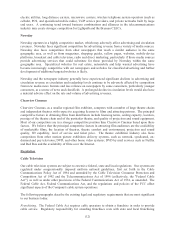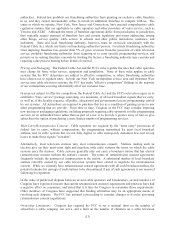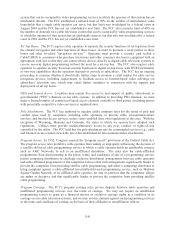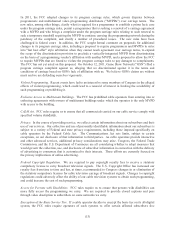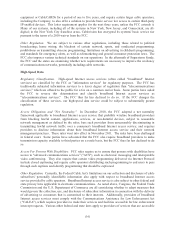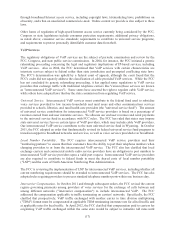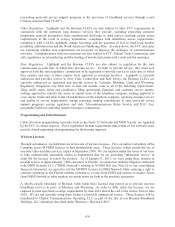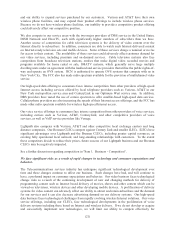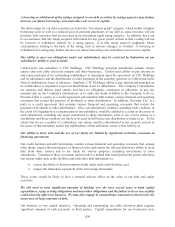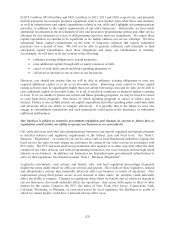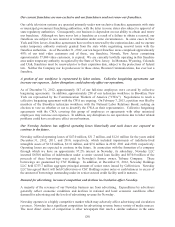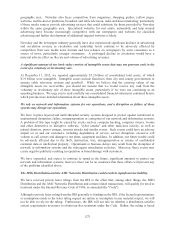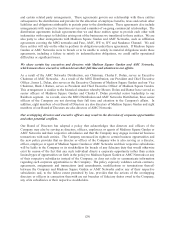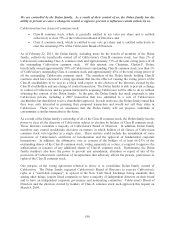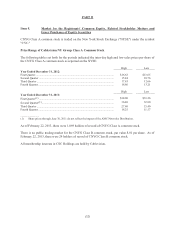Cablevision 2012 Annual Report Download - page 28
Download and view the complete annual report
Please find page 28 of the 2012 Cablevision annual report below. You can navigate through the pages in the report by either clicking on the pages listed below, or by using the keyword search tool below to find specific information within the annual report.(22)
subscribers, content and advertising. In addition, we may be required to make material capital and other
investments to anticipate and to keep up with technological change. These challenges could adversely
affect our business.
Programming costs of our cable television systems are increasing and we may not have the ability to
pass these increases on to our subscribers. Disputes with programmers can adversely affect our
relationship with subscribers and lead to subscriber losses.
Programming costs paid by our cable television systems are one of our largest categories of expenses.
These costs have increased rapidly and are expected to continue to increase, particularly with respect to
costs for sports programming and broadcast networks. We may not be able to pass programming cost
increases on to our subscribers due to the increasingly competitive environment. If we are unable to pass
these increased programming costs on to our subscribers, our operating results would be adversely
affected.
We attempt to control our programming costs and, therefore, the cost of our video services to our
customers by negotiating favorable terms for the renewal of our affiliation agreements with programmers.
On certain occasions in the past, such negotiations have led to disputes with programmers that have
resulted in temporary periods where we were not carrying a particular programming service or services.
Such disputes may inconvenience some of our subscribers and can lead to customer dissatisfaction and, in
certain cases, the loss of customers.
The financial markets are subject to volatility and disruptions, which have in the past, and may in the
future, adversely affect our business, including by affecting the cost of new capital, our ability to
refinance our scheduled debt maturities and our ability to meet our other obligations as they come due.
The recent economic downturn has adversely affected our business and future downturns may
continue to do so.
The capital and credit markets experience volatility and disruption. At times, the markets have exerted
extreme downward pressure on stock prices and upward pressure on the cost of new debt capital and have
severely restricted credit availability for most issuers.
The market disruptions in recent years were accompanied by a broader economic downturn, which led to
lower demand for our products, such as cable television services and entertainment, as well as lower
levels of television and newspaper advertising, and increased incidence of customers' inability to pay for
the services we provide. Continuation of those conditions may further adversely impact our results of
operations, cash flows and financial position.
We rely on the capital markets, particularly for offerings of debt securities, as well as the credit markets,
to meet our financial commitments and liquidity needs. Disruptions and/or volatility in the capital and
credit markets could adversely affect our ability to refinance on satisfactory terms, or at all, our scheduled
debt maturities and could adversely affect our ability to draw on our revolving credit facilities.
Economic downturns may impact our ability to comply with the covenants and restrictions in our
indentures, credit facilities and agreements governing our other indebtedness and may impact our ability
to pay our indebtedness as it comes due. If we do not repay our debt obligations when they become due
and do not otherwise comply with the covenants and restrictions in our indentures, credit facilities and
agreements governing our other indebtedness, we would be in default under those agreements, and the
debt incurred under those agreements could then be declared immediately due and payable. In addition,
any default under our indentures, credit facilities or agreements governing our other indebtedness could
lead to an acceleration of debt under other debt instruments that contain cross acceleration or cross-
default provisions. If the indebtedness under our indentures, credit facilities and our other debt
instruments were accelerated, we would not have sufficient assets to repay amounts due thereunder. To
avoid a default, we could be required to defer capital expenditures, sell assets, seek strategic investments


